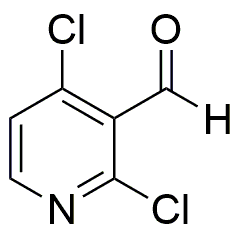2,4-Dichloro-3-pyridinecarboxaldehyde is widely utilized in research focused on:
- Synthesis of Pharmaceuticals: This compound serves as an important intermediate in the synthesis of various pharmaceutical agents, particularly in the development of anti-inflammatory and antimicrobial drugs.
- Agricultural Chemicals: It is used in formulating agrochemicals, including herbicides and fungicides, helping to improve crop yield and protect plants from pests and diseases.
- Research in Organic Chemistry: Researchers use it as a building block in organic synthesis, facilitating the creation of complex molecules for academic and industrial applications.
- Material Science: The compound is explored in the development of new materials, including polymers and coatings, which can enhance durability and performance in various applications.
- Biochemical Studies: It is utilized in biochemical research to study enzyme interactions and metabolic pathways, contributing to advancements in understanding biological processes.
General Information
Properties
Safety and Regulations
Applications
2,4-Dichloro-3-pyridinecarboxaldehyde is widely utilized in research focused on:
- Synthesis of Pharmaceuticals: This compound serves as an important intermediate in the synthesis of various pharmaceutical agents, particularly in the development of anti-inflammatory and antimicrobial drugs.
- Agricultural Chemicals: It is used in formulating agrochemicals, including herbicides and fungicides, helping to improve crop yield and protect plants from pests and diseases.
- Research in Organic Chemistry: Researchers use it as a building block in organic synthesis, facilitating the creation of complex molecules for academic and industrial applications.
- Material Science: The compound is explored in the development of new materials, including polymers and coatings, which can enhance durability and performance in various applications.
- Biochemical Studies: It is utilized in biochemical research to study enzyme interactions and metabolic pathways, contributing to advancements in understanding biological processes.
Documents
Safety Data Sheets (SDS)
The SDS provides comprehensive safety information on handling, storage, and disposal of the product.
Product Specification (PS)
The PS provides a comprehensive breakdown of the product’s properties, including chemical composition, physical state, purity, and storage requirements. It also details acceptable quality ranges and the product's intended applications.
Certificates of Analysis (COA)
Search for Certificates of Analysis (COA) by entering the products Lot Number. Lot and Batch Numbers can be found on a product’s label following the words ‘Lot’ or ‘Batch’.
*Catalog Number
*Lot Number
Certificates Of Origin (COO)
This COO confirms the country where the product was manufactured, and also details the materials and components used in it and whether it is derived from natural, synthetic, or other specific sources. This certificate may be required for customs, trade, and regulatory compliance.
*Catalog Number
*Lot Number
Safety Data Sheets (SDS)
The SDS provides comprehensive safety information on handling, storage, and disposal of the product.
DownloadProduct Specification (PS)
The PS provides a comprehensive breakdown of the product’s properties, including chemical composition, physical state, purity, and storage requirements. It also details acceptable quality ranges and the product's intended applications.
DownloadCertificates of Analysis (COA)
Search for Certificates of Analysis (COA) by entering the products Lot Number. Lot and Batch Numbers can be found on a product’s label following the words ‘Lot’ or ‘Batch’.
*Catalog Number
*Lot Number
Certificates Of Origin (COO)
This COO confirms the country where the product was manufactured, and also details the materials and components used in it and whether it is derived from natural, synthetic, or other specific sources. This certificate may be required for customs, trade, and regulatory compliance.


